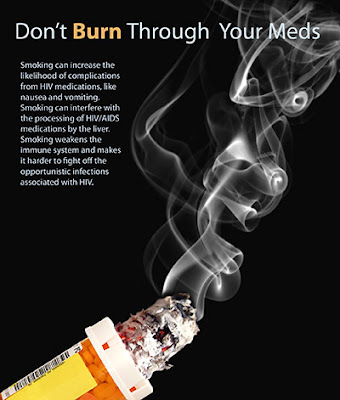By: Brandon M. Macsata, CEO, ADAP Advocacy Association
In 2021, we started a new tradition by "giving thanks" to the things important to our organization, as well as me, personally. All too often we get caught up in the nuances of our advocacy work, and monitoring the dysfunctional legislative logjam that has become commonplace in our nation's capital (especially, keeping an eye out for dangerous legislation, such as S.4395), as well as chasing potential funders so we can keep the proverbial lights on. This tradition was started, in large part, because we lost our Lion of the modern-day HIV/AIDS advocacy movement: Bill Arnold.
 |
| Eddie Hamilton (l) with Bill Arnold (r) |
Sadly, we lost another giant personality in our ongoing fight to end the HIV epidemic. On July 12th, Edward "Eddie" Hamilton passed from this life into the next, but not without leaving his mark on many of our lives. Eddie was special because held state and local health departments to account; he held commercial healthcare providers and retail pharmacies to account; he held community-based organizations to account; he held advocacy coalitions to account; and he also held all of us to account, always reminding anyone who could hear his voice why we are here doing this work…for the patient. But I'm giving thanks for having known such a wonderful, unique, and complicated human being.
Next, I'm giving thanks to the VOTERS (...well, a majority of them) because they rejected the politics of anger, division, hate, and violence! Our Democracy is too sacred, too important. Two years ago, we witness a former president desperately clinging to power incite a seditious mob to attack the very symbol of our government. The law enforcement sworn to protect our government officials were beaten; people died. Yet, we didn't forget about it and on November 8th, America said...enough!!!
That statement was pretty intense, but it needed to be made.
I'm also giving thanks to Phil, Wanda, Jen, Eric, Lyne, Hilary, Lisa, Glen, Jennifer, Theresa, and Guy. As my board of directors, they embody a commitment to excellence. Some of these folks have served in their leadership role for many years; others, only a few. Collectively they have contributed so much of their experience, knowledge and passion into making the ADAP Advocacy Association more effective as a patient advocacy organization. I'm also giving thanks to our longtime board member, Elmer Cerano, who recently stepped-down from our board of directors after serving for fourteen years! He was our compass, always ensuring that we never veered from the path our mission.
This year, we embarked on an ambitious project to advance better patient advocacy surrounding access to HIV Long-Acting Agents (LAAs). Our ADAP Injectables Advisory Committee included Michelle Anderson with the Afiya Center, Tori Cooper with the Human Rights Campaign Foundation, Donna Sabatino with The AIDS Institute, Jennifer Eliasi MS, RD, CDN with Theratechnologies, Marcus Hopkins with Appalachian Learning Initiative, Jen Laws with the Community Access National Network (CANN), Warren Alexander O'Meara-Dates with The 6:52 Project Foundation, Dawn Patillo-Exum with Merck, Glen Pietrandoni, R.Ph with Avita Pharmacy, Cindy Snyder with ViiV Healthcare, Alex Vance with the International Association of Providers of AIDS Care (IAPAC), Marcus Wilson with Janssen Pharmaceutical Companies of Johnson & Johnson, and Joey Wynn with the Florida HIV/AIDS Advocacy Network (FHAAN). I'm giving thanks to each and every one of you for the amazing work you completed on our behalf!
In last year's thankful reflection, I said: "The dogmatic claims that industry funding is paramount to a bride are not only unfounded, they're also unhelpful to our collective efforts to improve access to care and treatment." It still holds quite true, and thus why I'm giving thanks to our industry, and non-industry funders, including AbbVie, AIDS Alabama, Avita Pharmacy, Bender Consulting Services, Brii Biosciences, Bristol-Myers Squibb, Community Access National Network, Gilead Sciences, Janssen Pharmaceutical Companies of Johnson & Johnson, Magellan Rx Management, Maxor National Pharmacy Services Company, MedData Services, Merck, Napo Pharmaceuticals, North Carolina AIDS Action Network, Novartis, Partnership for Safe Medicines, Patient Access Network Foundation, Patient Advocate Foundation, PayPal Giving Fund, Pharmaceutical Research and Manufacturers of America, Ramsell Corporation, ScriptGuideRx, Theratechnologies, ViiV Healthcare, and Walgreens. Giving thanks to our small donors, too. You could donate to so many other charities, yet you choose to support us!
 |
| Sebastian Ryan Macsata |
And once again, I'm giving thanks to my four-year son, Sebastian. Being your Pa Pa is the most joyous part of my life and I couldn't imagine a day without your smile starting off my day. I'm thankful for being able to witness your innocence, because it reminds me that there is still good in this crazy world.
Finally, giving thanks to YOU for reading our blogs every week. Happy Thanksgiving!
Disclaimer: Guest blogs do not necessarily reflect the views of the ADAP Advocacy Association, but rather they provide a neutral platform whereby the author serves to promote open, honest discussion about public health-related issues and updates.








